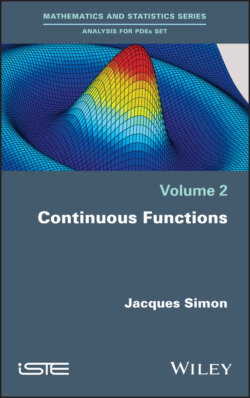Читать книгу Continuous Functions - Jacques Simon - Страница 2
Table of Contents
Оглавление1 Cover
2 Title Page
3 Copyright Page
4 Introduction
5 Familiarization with Semi-normed Spaces
6 Notations
7 Chapter 1: Spaces of Continuous Functions 1.1 Notions of continuity 1.2 Spaces С(Ω; E), Сb(Ω; E), СK(Ω; E), С(Ω; E) and Сb(Ω; E) 1.3 Comparison of spaces of continuous functions 1.4 Sequential completeness of spaces of continuous functions 1.5 Metrizability of spaces of continuous functions 1.6 The space 1.7 Continuous mappings 1.8 Continuous extension and restriction 1.9 Separation and permutation of variables 1.10 Sequential compactness in Cb(Ω; E)
8 Chapter 2: Differentiable Functions 2.1 Differentiability 2.2 Finite increment theorem 2.3 Partial derivatives 2.4 Higher order partial derivatives 2.5 Spaces and 2.6 Comparison and metrizability of spaces of differentiable functions 2.7. Filtering properties of spaces of differentiable functions 2.8. Sequential completeness of spaces of differentiable functions 2.9. The space and the set
9 Chapter 3: Differentiating Composite Functions and Others 3.1. Image under a linear mapping 3.2. Image under a multilinear mapping: Leibniz rule 3.3. Dual formula of the Leibniz rule 3.4. Continuity of the image under a multilinear mapping 3.5. Change of variables in a derivative 3.6. Differentiation with respect to a separated variable 3.7. Image under a differentiable mapping 3.8. Differentiation and translation 3.9. Localizing functions
10 Chapter 4: Integrating Uniformly Continuous Functions 4.1. Measure of an open subset of 4.2. Integral of a uniformly continuous function 4.3. Case where E is not a Neumann space 4.4. Properties of the integral 4.5. Dependence of the integral on the domain of integration 4.6. Additivity with respect to the domain of integration 4.7. Continuity of the integral 4.8. Differentiating under the integral sign
11 Chapter 5: Properties of the Measure of an Open Set 5.1. Additivity of the measure 5.2. Negligible sets 5.3. Determinant of d vectors 5.4. Measure of a parallelepiped
12 Chapter 6: Additional Properties of the Integral 6.1. Contribution of a negligible set to the integral 6.2. Integration and differentiation in one dimension 6.3. Integration of a function of functions 6.4. Integrating a function of multiple variables 6.5. Integration between graphs 6.6. Integration by parts and weak vanishing condition for a function 6.7. Change of variables in an integral 6.8. Some particular changes of variables in an integral
13 Chapter 7: Weighting and Regularization of Functions 7.1. Weighting 7.2. Properties of weighting 7.3. Weighting of differentiable functions 7.4. Local regularization 7.5. Global regularization 7.6. Partition of unity 7.7. Separability of K∞(Ω)
14 Chapter 8: Line Integral of a Vector Field Along a Path 8.1. Paths 8.2. Line integral of a field along a path 8.3. Line integral along a concatenation of paths 8.4. Tubular flow and the concentration theorem 8.5. Invariance under homotopy of the line integral of a local gradient
15 Chapter 9: Primitives of Continuous Functions 9.1. Explicit primitive of a field with line integral zero 9.2. Primitive of a field orthogonal to the divergence-free test fields 9.3. Gluing of local primitives on a simply connected open set 9.4. Explicit primitive on a star-shaped set: Poincaré’s theorem 9.5. Explicit primitive under the weak Poincaré condition 9.6. Primitives on a simply connected open set 9.7. Comparison of the existence conditions for a primitive 9.8. Fields with local primitives but no global primitive 9.9. Uniqueness of primitives 9.10. Continuous primitive mapping
16 Chapter 10: Additional Results: Integration on a Sphere 10.1. Surface integration on a sphere 10.2. Properties of the integral on a sphere 10.3. Radial calculation of integrals 10.4. Surface integral as an integral of dimension d − 1 10.5. A Stokes formula
17 Appendix: Reminders A.1. Notation and numbering A.2. Semi-normed spaces A.3. Continuous mappings and duality A.4. Differentiable mappings and differentiable functions
18 Bibliography
19 Index
20 Other titles from ISTE in Mathematics and Statistics
21 End User License Agreement
